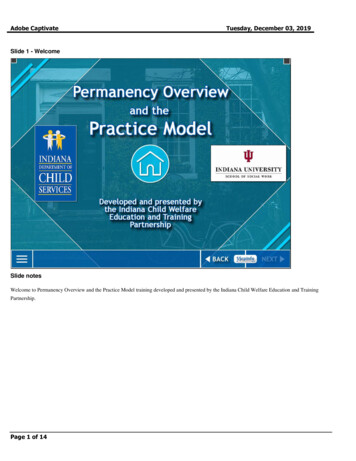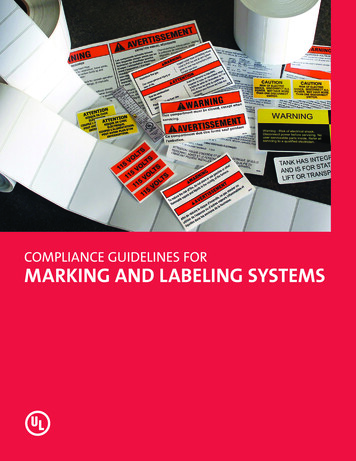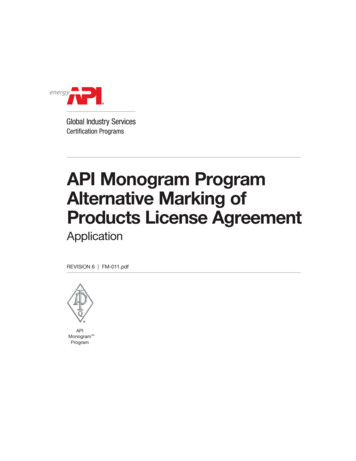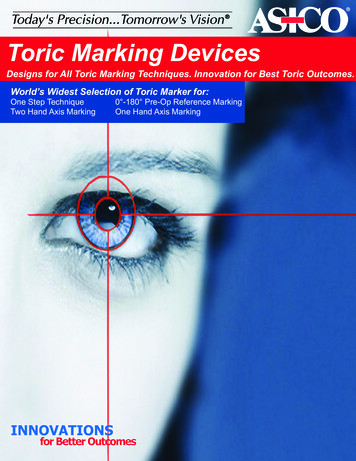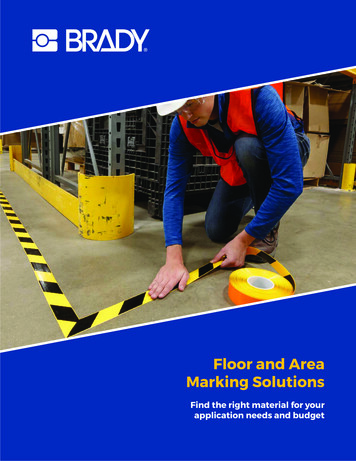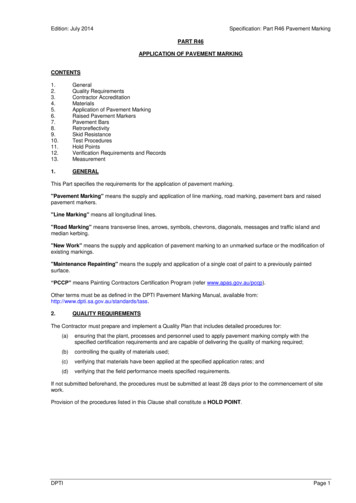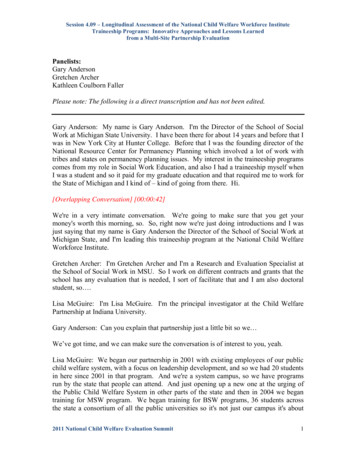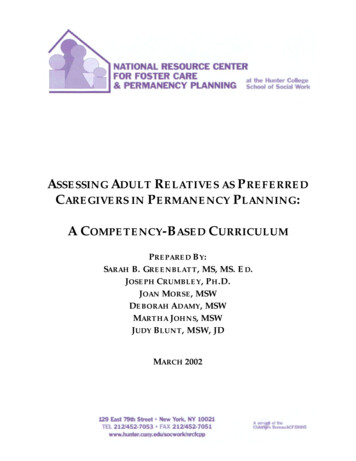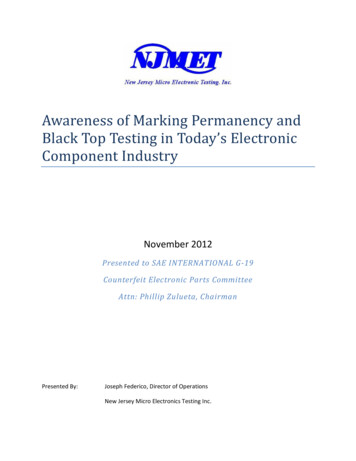
Transcription
Awareness of Marking Permanency andBlack Top Testing in Today’s ElectronicComponent IndustryNovember 2012Presented to SAE INTERNATIONAL G-19Counterfeit Electronic Parts CommitteeAttn: Phillip Zulueta, ChairmanPresented By:Joseph Federico, Director of OperationsNew Jersey Micro Electronics Testing Inc.
Awareness of Marking Permanency and Black Top Testing in Today’s Electronic Component IndustryNovember 2012Page 2
Awareness of Marking Permanency and Black Top Testing in Today’s Electronic Component IndustryContentsBackground . 4Issue: One testing approach does not fit all components . 4Counterfeiting – A Worldwide Dilemma. 4Suspect marking after testing . 4Marking Permanency/Blacktop Testing Today . 5EXEMPLAR: The Case of a Known Good Component Failing Dynasolve Testing . 5Conclusion . 7Appendix . 8Appendix 1: Resistance to Solvents – Microcircuits (Ceramic Devices) . 8MIL-STD-883H . 8METHOD 2015.13. 8RESISTANCE TO SOLVENTS . 8MIL-STD-750E . 14Appendix 2: Testing for Plastic Parts: Marking Permanency (Resistance to Solvents) . 17Test 1 (Mineral Spirits) . 17Test 2 (Acetone Test) . 19Test 3 (1-Methyl 2-Pyrrolidone Test) . 20Test 4 (Dynasolve 711/750) . 22Appendix 3: Original Certificate of Conformance . 24November 2012Page 3
Awareness of Marking Permanency and Black Top Testing in Today’s Electronic Component IndustryBackgroundIssue: One testing approach does not fit all componentsOver the past few years new techniques of black top marking tests have been implemented to discovernon authentic marking and coating processes on electronic component devices. These tests can behighly effective at discovering counterfeit plastic components. However, the same tests can result infalse positives when used on ceramic packages that have not been blacktopped/coated or on canpackage devices. We suggest that resistance to solvents testing be performed on these devices inaccordance with MIL-STD 750 and MIL-STD 883 to evaluate the device’s marking permanency testing.Counterfeiting – A Worldwide DilemmaCounterfeit devices are becoming harder to detect unless properly investigated since the counterfeitersthemselves are learning and adapting to production, manufacturing and testing techniques.A common method of counterfeiting is to take similar devices, change the markings and repackage themto appear as the correct device. Because similar devices are used, they might even pass full functionaland parametric testing.Suspect marking after testingNovember 2012Page 4
Awareness of Marking Permanency and Black Top Testing in Today’s Electronic Component IndustryMarking Permanency/Blacktop Testing Today Marking permanency testing can reveal many re-marks, black topping, sanding, etc.Mineral Spirits Testing, Acetone Testing, 1- Methyl 2- Pyrrolidone Testing and Dynasolve Testinghave been vital in uncovering many anomalies associated with counterfeit marked units onplastic packages that have been blacktopped.The above tests are now commonly used for testing all components, including those made ofplastic, ceramic (non-blacktopped) and canned package components.EXEMPLAR: The Case of a Known Good Component Failing Dynasolve TestingThis example demonstrates a known good part -- Texas Instruments SNJ54HC4040J -- which failed theDynasolve testing. The same part passed the MIL STD Marking Permanency Test. As shown below, theparts that were tested had a valid Certificate of Conformance.Original Certificate of Conformance –See Appendix 3 for a larger version of this documentNovember 2012Page 5
Awareness of Marking Permanency and Black Top Testing in Today’s Electronic Component IndustryExemplar, Known Authentic Parts, Passing MIL STD Marking PermanencyTestExemplar – Known Authentic Parts Failing Dynasolve Marking Permanency TestNovember 2012Page 6
Awareness of Marking Permanency and Black Top Testing in Today’s Electronic Component IndustryConclusionWhile Mineral Spirits testing, Acetone testing, 1- Methyl 2- Pyrrolidone testing and Dynasolve testinghave been vital in uncovering many anomalies associated with counterfeit marked units on plastic andceramic parts that have been black topped. We have shown that using the very same four stepprocesses can, in fact, reject a known authentic ceramic (hermetically sealed) unit that has not beenblack topped.We recommend that any hermetically sealed (Ceramic or Can Package) device not showing any evidenceof Black Top Marking should undergo a Resistance to Solvent Test in accordance with its respective MILSTANDARD to evaluate Marking Permanency and not rely on the blacktop marking resistance to solventstests.November 2012Page 7
Awareness of Marking Permanency and Black Top Testing in Today’s Electronic Component IndustryAppendixAppendix 1: Resistance to Solvents – Microcircuits (Ceramic Devices)MIL-STD-883HMETHOD 2015.13RESISTANCE TO SOLVENTSApplication of Resistance to Solvents Test Marking Permanency Per MIL STD 883, Method 2015.31. PURPOSE. The purpose of this test is to verify that the markings will not become illegible on thecomponent parts when subjected to solvents. The solvents will not cause deleterious, mechanical orelectrical damage, or deterioration of the materials or finishes.1.1 Formulation of solvents. The formulation of solvents herein is considered typical andrepresentative of the desired stringency as far as the usual coatings and markings are concerned.Many available solvents which could be used are either not sufficiently active, too stringent, or evendangerous to humans when in direct contact or when the fumes are inhaled.1.2 Check for conflicts. When this test is referenced, care should be exercised to assure thatconflicting requirements, as far as the properties of the specified finishes and markings are concerned,are not invoked.November 2012Page 8
Awareness of Marking Permanency and Black Top Testing in Today’s Electronic Component IndustryApplication of Resistance to Solvents Test Marking Permanency Per MIL STD 883, Method 2015.3 StepA2.MATERIALS.2.1 Solvent solutions. The solvent solutions used in this test shall consist of the following: 1/a. At 20-30 C a mixture consisting of the following:(1)One part by volume of an aliphatic alcohol and/or aliphatic ester, USP grade or better.(2)Three parts by volume of mineral spirits in accordance with A-A-2904, type II,previously designated as TT-T-291, type II, grade A, or three parts by volume of amixture of 80 percent by volume of kerosene and 20 percent by volume ofethylbenzene.b. A semiaqueous or nonaqueous based organic solvent e.g., a terpene or heterocyclic compound.2/c. This solvent has been deleted. When a suitable replacement for this solvent has been found,it will be added as solution c.d. At 63 C to 70 C. a mixture consisting of the following: 1/(1)42 parts by volume of deionized water.November 2012Page 9
Awareness of Marking Permanency and Black Top Testing in Today’s Electronic Component Industry(2)1 part by volume of propylene glycol monomethyl ether.(3)1 part by volume of monoethanolamine or equivalent inorganic base to achieve the same pH.2.1.1 Solvent solutions, safety aspects. Solvent solutions listed in a through d above exhibit somepotential for health and safety hazards. The following safety precautions should be observed:a.Avoid contact with eyes.b.Avoid prolonged contact with skin.c.Provide adequate ventilation.d.Avoid open flame.e.Avoid contact with very hot surfaces.1/ Normal safety precautions for handling these solutions (e.g., same as those for dilutedammonium hydroxide) based on O.S.H.A rules for Monoethanolamine or other precautionary measureswith regard to flash point, toxicity, etc.2/ Or any EPA demonstrated equivalent. When using EPA approved alternative solutions fortest, the device manufacturer should consider the recommended temperature for cleaningspecified by the solvent supplier.2.2 Vessel. The vessel shall be a container made of inert material, and of sufficient size to permitcomplete immersion of the specimens in the solvent solutions specified in 2.1.2.3 Brush. The brush shall be a toothbrush with a handle made of a nonreactive material. Thebrush shall have at least three long rows of hard (or firm) bristles, the free ends of which shall liesubstantially in the same plane. The toothbrush shall be used exclusively with a single solvent andwhen there is any evidence of softening, bending, wear, or loss of bristles, it shall be discarded.November 2012Page 10
Awareness of Marking Permanency and Black Top Testing in Today’s Electronic Component IndustryApplication of Resistance to Solvents Test Marking Permanency Per MIL STD 883, Method 2015.3 Step B3. PROCEDURE. The specimens subjected to this test shall be divided into three equal groups. Eachgroup shall be individually subjected to one of the following procedures:Note: Metal lidded leadless chip carrier (LCC) packages shall be preconditioned by immersing thespecimens in room temperature flux type symbols "A" or "B" (flux types "LO" or "L'1) in accordancewith ANSI/J-STD-004 previously designated as RMA flux in accordance with MIL-F-14256, for 5 to10 seconds. The specimens shall then be subjected to an ambient temperature of 215 C 5 C for60 seconds 5, -0 seconds. After the preconditioning, each device lid shall be cleaned withisopropyl alcohol.a.The first group shall be subjected to the solvent solution as specified in 2.1a maintained at atemperature of 25 C 5 C.b.The second group shall be subjected to the solvent solution as specified in 2.1bmaintained at a suitable temperature.c.This solution has been deleted, (see 2.1c),d.The fourth group shall be subjected to the solvent solution as specified in 2.1d maintained at atemperature of 63 C to 70 C.The specimens and the bristle portion of the brush shall be completely immersed for 1 minute minimumin the specified solution contained in the vessel specified in 2.2. Immediately following emersion,the specimen shall be brushed with normal hand pressure (approximately 2 to 3 ounces) for 10 strokeson the portion of the specimen where marking has been applied, with the brush specified in 2.3,Immediately after brushing, the above procedure shall be repeated two additional times, for a total ofNovember 2012Page 11
Awareness of Marking Permanency and Black Top Testing in Today’s Electronic Component Industrythree immersions followed by brushings. The brush stroke shall be directed in a forward direction,across the surface of the specimen being tested. After completion of the third immersion andbrushing, devices shall be rinsed and all surfaces air blown dry. After 5 minutes, the specimens shall beexamined to determine the extent, if any, of deterioration that was incurred.3.1 Optional procedure for the fourth group. The test specimens shall be located on a test surface ofknown area which is located 15 2.5 centimeters (6 1 inches) below a spray nozzle(s) which discharges0.6 0.02 liters/minute (0.139 gpm) of solution (2.1d) per 6.5 square centimeters (1 in 2)surface areaat a pressure of 140 30 kilopascal (20 5 psi). The specimens shall be subjected to this spray for aperiod of 10 minutes minimum. After removal and within 5 minutes the specimens shall be examined inaccordance with 3.1.1. The specimens may be rinsed with clear water and air blow dried prior toexamination.3.1.1 Failure criteria. After subjection to the test, evidence of damage to the device and any specifiedmarkings which are missing in whole or in part, faded, smeared, blurred, or shifted (dislodged) to theextent that they cannot be readily identified from a distance of at least 15.0 cm (6 inches) with normalroom lighting and without the aid of magnification or with a viewer having a magnification no greaterthan 3X shall constitute a failure.Application of Resistance to Solvents Test Marking Permanency Per MIL STD 883, Method 2015.3 StepD, including chemical heatingNovember 2012Page 12
TABLE 1: Summary Table for Resistance to SolventsSolvent 1Solvent 2Solvent 3Solvent 41 part (by volume) of isopropyl alcohol(ACS reagent grade or TT- -735, grade Aor B and 3 parts (by volume) of mineralspirits per Mil-Prf-680, type L, or threeparts (by volume) of kerosene and 20%(by volume) ethylbenzeneThis solvent has been deletedTerpene defluxer42 parts (by volume) of water1 part (by volume) of propylene glycomonomethyl ether1 part (by volume) of monoethanolamineImmersion 3 .5 -0 minutes, 25 C to -5 C.Immersion 3 .5 -0 minutes, 25 C to -5 C.Immersion 3 .5 -0 minutes, 63 C to 70 C.Brush 10 stokes (wet bristle) 2 to 3 ozBrush 10 stokes (wet bristle) 2 to 3 ozBrush 10 stokes (wet bristle) 2 to 3 ozImmersion 3 .5 -0 minutes, 25 C to -5 C.Immersion 3 .5 -0 minutes, 25 C to -5 C.Immersion 3 .5 -0 minutes, 63 C to 70 C.Brush 10 stokes (wet bristle) 2 to 3 ozBrush 10 stokes (wet bristle) 2 to 3 ozBrush 10 stokes (wet bristle) 2 to 3 ozImmersion 3 .5 -0 minutes, 25 C to -5 C.Immersion 3 .5 -0 minutes, 25 C to -5 C.Immersion 3 .5 -0 minutes, 63 C to 70 C.Brush 10 stokes (wet bristle) 2 to 3 ozBrush 10 stokes (wet bristle) 2 to 3 ozBrush 10 stokes (wet bristle) 2 to 3 ozRinse in waterRinse in waterAir blow dryAir blow dryAir blow dryInspect at 3X maximum for marking.Inspect at 10X maximum for partdamage.Inspect at 3X maximum for marking.Inspect at 10X maximum for partdamage.Inspect at 3X maximum for marking.Inspect at 10X maximum for partdamage.
Awareness of Marking Permanency and Black Top Testing in Today’s Electronic Component IndustryMIL-STD-750EMETHOD 1022.5 Semiconductors (Can packages)RESISTANCE TO SOLVENTS1. Purpose. The purpose of this test is to verify that the markings will not become illegibleon the component parts when subjected to solvents. The solvents will not cause deleterious,mechanical or electrical damage, or deterioration of the materials or finishes.1.1 Formulation of solvents. The formulation of solvents herein is considered typical andrepresentative of the desired stringency as far as the usual coatings and markings are concerned.Many available solvents which could be used are either not sufficiently active, too stringent, oreven dangerous to humans when in direct contact or when the fumes are inhaled.1.2 Check for conflicts. When this test is referenced, care should be exercised to assurethat conflicting requirements, as far as the properties of the specified finishes and markings areconcerned, are not invoked.2.Materials.2.1 Solvent solutions. The solvent solutions used in this test shall consist of the following:a. A mixture consisting of the following:(1)One part by volume of isopropyl alcohol, AC.S. (American Chemical Society)Reagent Grade, or isopropyl alcohol in accordance with TT-I-735, grade A or B-(2)Three parts by volume of mineral spirits in accordance with MIL -PRF-680, type II,grade A, or three parts by volume of a mixture of 80 percent by volume of kerosene and20 percent by volume ethylbenzene.b. A semiaqueous based solvent (defluxer (e.g., a turpene)) consisting of a minimum of 60percent Limonene and a surfactant heated to 32 C 5 C. 1/c. At 63 C to 70 C, a mixture consisting of the following: 2/(1)42 parts by volume of deionized water.(2)1 part by volume of propylene glycol monomethyl ether.(3)1 part by volume of monoethanolamine.2.1.1 Solvent solutions, safety aspects. Solvent solutions listed in 2.1 herein exhibit somepotential for health and safety hazards. The following safety precautions should be observed:a.Avoid contact with eyes.November 2012Page 14
Awareness of Marking Permanency and Black Top Testing in Today’s Electronic Component Industryb.Avoid prolonged contact with skin.c.Provide adequate ventilation.d.Avoid open flame.e.Avoid contact with very hot surfaces.1/ Or any equivalent Environmental Protection Agency (EPA) approvedHydrochlorofluorocarbons (HCFC) or terpene solvent or demonstrated equivalent.2/ Normal safety precaution for handling this solution (e.g., same as those for dilutedammonium hydroxide) based on Occupational Safety and Health Administration (O.S.H.A.)rules for monoethanolamine.2.2 Vessel. The vessel shall be a container made of inert material, and of sufficient size topermit complete immersion of the specimens in the solvent solutions specified in 2.1.2.3 Brush. The brush shall be a brush with a handle made of a nonreactive material. The brushshall have three long rows of hard bristles, the free ends of which shall lie substantially in thesame plane. The brush shall be used exclusively with a single solvent and when there is anyevidence of softening, bending, wear, or loss of bristles, it shall be discarded.3. Procedure. The specimens subjected to this test shall be divided into three groups. Metallidded leadless chip carrier (LCC) packages shall be preconditioned by immersing the specimens inroom temperature ROL1 flux (in accordance with J-STD-004A, Requirements for Soldering Fluxes)for 5 to 10 seconds. The specimens shall then be subjected to an ambient temperature of 215 C 5 C for 60 seconds 5, -0 seconds. After the preconditioning, each device lid shall becleaned with isopropyl alcohol. Each group shall be individually subjected to one of the followingprocedures:a.The first group shall be subjected to the solvent solution as specified in 2.1.a. maintainedat a temperature of 25 C 5 C.b.The second group shall be subjected to the solvent solution as specified in 2.1.b.maintained at a temperature of 32 C 5 C.c.The third group shall be subjected to the solvent solution as specified in 2.1.c.maintained at a temperature of 63 C to 70 C.The specimens and the bristle portion of the brush shall be completely immersed for 1 minuteminimum in the specified solution contained in the vessel specified in 2.2. Immediately followingimmersion, the specimen shall be brushed with normal hand pressure (approximately 2 to 3ounces) for ten strokes on the portion of the specimen where marking has been applied, with thebrush specified in 2.3. Immediately after brushing, the above procedure shall be repeated twoadditional times, for a total of three immersions followed by brushings. The brush stroke shall bedirected in a forward direction, across the surface of the specimen being tested. After completionof the third immersion and brushing, devices shall be rinsed and all surfaces air blown dry. After 5November 2012Page 15
Awareness of Marking Permanency and Black Top Testing in Today’s Electronic Component Industryminutes, the specimens shall be examined to determine the extent, if any, of deterioration that wasincurred.3.1 Optional procedure for the third group. The test specimens shall be located on a testsurface of known area which is located 6 1 inches (15.24 2.54 centimeters) below a spray nozzle(s)which discharges 0.139 gpm(0.6 .0.02 liters) minute) of solution (see 2.1.c) 1 in 2 (6.5 square centimeters) of surface area at apressure of 20 5 psi (137.90 34.41 kilopascal). The specimens shall be subjected to this sprayfor a period of 10 minutes minimum. Within five minutes after removal of the specimens,they shall be examined in accordance with 3.1.1. The specimens may be rinsed with clear waterand air blown dried prior to examination.3.1.1 Failure criteria. After subject to the test, evidence of damage to the device and anyspecified markings which are missing in whole or in part, faded, smeared, blurred, or shifted(dislodged) to the extent that they cannot be readily identified from a distance of at least 6inches (15.24 cm) with normal room lighting, and without the aid of magnification, or with a viewerhaving a magnification no greater than 3X, shall constitute a failure,November 2012Page 16
Awareness of Marking Permanency and Black Top Testing in Today’s Electronic Component IndustryAppendix 2: Testing for Plastic Parts: Marking Permanency (Resistance toSolvents)PURPOSE: Marking permanency testing can reveal many re-marks, black topping, sanding, etc.Mineral Spirits Testing, Acetone Testing, 1- Methyl 2- Pyrrolidone Testing and Dynasolve Testinghave been vital in uncovering many anomalies associated with counterfeit marked units onplastic packages that have been blacktopped.Counterfeit Unit Showing Non Uniform Black Coat LayerTest 1 (Mineral Spirits)PROCEDURE: To perform this test mix a solution of 3 parts mineral spirits with 1 part alcohol. Dip acotton swab into the solution and wipe the swab across the part makings. The markings should notsmear or be removed. If they are removed or smeared this is a failure. SAVE THE SWABS USED TOPERFORM THE TEST and include with the parts when returned to the report writer.After the conclusion of this test, place all three devices under the camera and place the cotton swabnext to the devices. Take an optical photo, showing the results and label this photo RTS. This photoshould clearly show that the top coating did or did not come off the device. This photo must be placed inthe analysis photo folder in the database.November 2012Page 17
Awareness of Marking Permanency and Black Top Testing in Today’s Electronic Component IndustryPart Passing Mineral Spirits TestPart Failing Mineral Spirits TestNovember 2012Page 18
Awareness of Marking Permanency and Black Top Testing in Today’s Electronic Component IndustryTest 2 (Acetone Test)PROCEDURE: The first technique requires Acetone be applied to the cotton swab and lightly rubbedacross the surface. If the swab turns black, please stop and inform a report writer. SAVE THE SWABSUSED TO PERFORM THE TEST and include with the parts when returned to the report writer.Second technique requires the Acetone be applied to the swab and aggressively rubbed on the surface.The swab may be wetted several times and pressure applied to the same location multiple times beforeany effect is seen. SAVE THE SWABS USED TO PERFORM THE TEST and include with the parts whenreturned to the report writer.After the conclusion of this test place all three devices under the camera and along with the cotton swabnext to the devices and take an optical photo, showing the results (label this photo RTS 2). This photoshould clearly show that the top-coating did not come off the device. This photo must be placed in theanalysis photo folder in the database.Part Passing Acetone TestNovember 2012Page 19
Awareness of Marking Permanency and Black Top Testing in Today’s Electronic Component IndustryPart Failing Acetone TestTest 3 (1-Methyl 2-Pyrrolidone Test)PROCEDURE: When using 1-Methyl 2-Pyrrolidinone, suspend the part so that half of it is in the solutionand heat it to 115 120C for 2 to 5 minutes) the time and temperature may be adjusted to compensatedfor your sample). Once the part is removed from the solution, use a cotton swab to attempt to wipe thetop coating off (avoid markings if possible). The removed coating will show on the cotton swab as blackin color. SAVE THE SWABS USED TO PERFORM THE TEST and include with the parts when returned to thereport writer.After the conclusion of this test, place all three devices under the camera and along with the cottonswab next to the devices ad take an optical photo, showing the RTS results (label this photo RTS 3). Thisphoto should clearly show that the top coating did or did not come off the device. This photo must beplaced in the analysis photo folder into the database.November 2012Page 20
Awareness of Marking Permanency and Black Top Testing in Today’s Electronic Component IndustryParts Passing Methyl Pyrrolidone TestParts Failing Methyl Pyrrolidone TestNovember 2012Page 21
Awareness of Marking Permanency and Black Top Testing in Today’s Electronic Component IndustryTest 4 (Dynasolve 711/750)PROCEDURE: For Dynasolve 711/750, the process is similar to the 1-Methyl 2-Pyrrolidinone test but itused a lower temperature (105C) and the time increased to approximately 45 minutes. Suspend the partso that half of it is in the solution and heat it up to 105C for 45 minutes. Once the part is removed fromthe solution, use a cotton swab to attempt to wipe the top coating off (avoid markings if possible). Theremoved coating will show on the cotton swab as black in color. SAVE THE SWABS USED TO PERFORMTHE TEST and include with the parts when returned to the report writer.After the conclusion of this test, place all three devices under the camera and along with the cottonswab next to the devices and take an optical photo, showing the RTS results (label this photo RTS 4). Thisphoto should clearly show that the top coating did or did not come off the device. This photo must beplaced in the analysis photo folder in the database.Part Passing Dynasolve TestNovember 2012Page 22
Awareness of Marking Permanency and Black Top Testing in Today’s Electronic Component IndustryPart Failing Dynasolve TestNovember 2012Page 23
Awareness of Marking Permanency and Black Top Testing in Today’s Electronic Component IndustryAppendix 3: Original Certificate of ConformanceNovember 2012Page 24
MIL-STD-883H METHOD 2015.13 RESISTANCE TO SOLVENTS Application of Resistance to Solvents Test Marking Permanency Per MIL STD 883, Method 2015.3 1. PURPOSE. The purpose of this test is to verify that the markings will not become illegible on the component parts when subjected to solvents. The solvents will not cause deleterious, mechanical or
